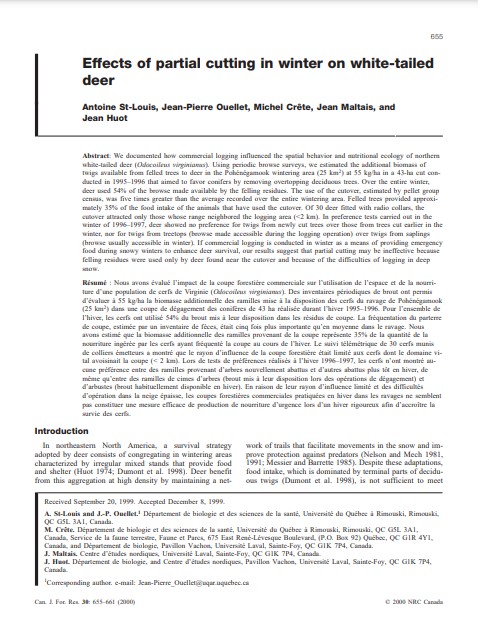Effects of partial cutting in winter on white-tailed deer
Bosque Modelo:
Bas-Saint-Laurent
Temática:
Gestión forestal
Tipo de documento:
Artículo científico
Resumen
We documented how commercial logging influenced the spatial behavior and nutritional ecology of northern white-tailed deer (Odocoileus virginianus). Using periodic browse surveys, we estimated the additional biomass of twigs available from felled trees to deer in the Pohénégamook wintering area (25 km2 ) at 55 kg/ha in a 43-ha cut conducted in 1995–1996 that aimed to favor conifers by removing overtopping deciduous trees. Over the entire winter, deer used 54% of the browse made available by the felling residues. The use of the cutover, estimated by pellet group census, was five times greater than the average recorded over the entire wintering area. Felled trees provided approximately 35% of the food intake of the animals that have used the cutover. Of 30 deer fitted with radio collars, the cutover attracted only those whose range neighbored the logging area (<2 km). In preference tests carried out in the winter of 1996–1997, deer showed no preference for twigs from newly cut trees over those from trees cut earlier in the winter, nor for twigs from treetops (browse made accessible during the logging operation) over twigs from saplings (browse usually accessible in winter). If commercial logging is conducted in winter as a means of providing emergency food during snowy winters to enhance deer survival, our results suggest that partial cutting may be ineffective because felling residues were used only by deer found near the cutover and because of the difficulties of logging in deep snow.
Información Bibliográfica
Autor:
St-Louis, A, J-P Ouellet, M Crête, J Maltais and J Huot.
Revista:
Canadian Journal of Forest Research
Año:
2000
N°:
-
País :
Canadá
Páginas:
655 - 661
Volumen:
30
Idioma:
Ingles
Palabras claves
Impact, Model Forest





